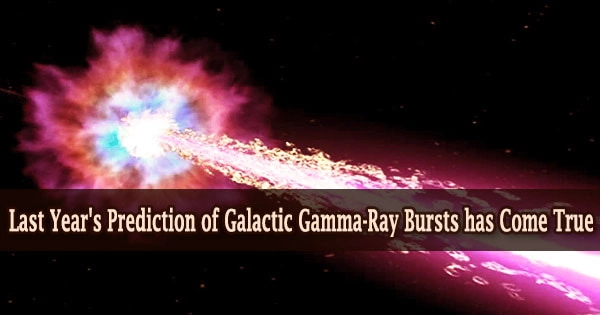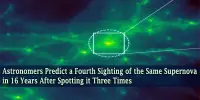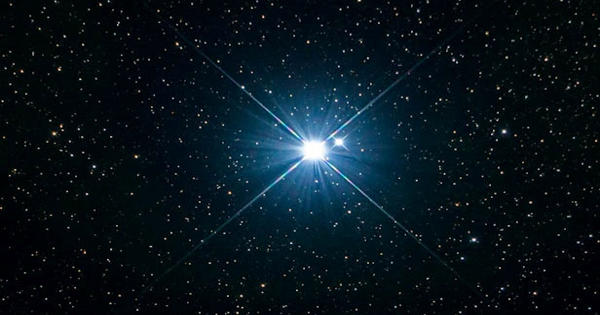Magnetars are strange objects that are gigantic, spinning neutron stars with some of the strongest magnetic fields known, capable of emitting brief bursts of radio waves that can be seen across the universe.
Another feature of magnetars has been discovered by a team of astrophysicists: they can generate bursts of low-energy gamma rays in a pattern never observed before in any other celestial object.
It’s unclear why this occurs, but magnetars are a mystery, with thousands of ideas on how they produce radio and gamma-ray bursts. The discovery of this peculiar pattern of gamma-ray activity may aid theorists in deciphering the mechanisms at work.
“Magnetars, which are connected with fast radio bursts and soft gamma repeaters, have something periodic going on, on top of randomness,” said astrophysicist Bruce Grossan, an astrophysicist at the University of California, Berkeley’s Space Sciences Laboratory (SSL). “This is another mystery on top of the mystery of how the bursts are produced.”
The pattern was discovered in bursts from a soft gamma repeater, SGR1935+2154, that is a magnetar, a prolific source of soft or lower energy gamma-ray bursts and the only known source of fast radio bursts within our Milky Way galaxy, by Grossan, theoretical physicist and cosmologist Eric Linder from UC Berkeley, and postdoctoral fellow Mikhail Denissenya from Nazarbaye
They discovered that the object produces bursts at random, but only between four-month periods, each with three months of quiet in between.
On March 19, the researchers published a preprint asserting “periodic windowed behavior” in soft gamma bursts from SGR1935+2154, predicting that after a three-month hiatus, these bursts would resume after June 1 and might last for a four-month period concluding Oct. 7.
These new bursts within this window means that our prediction is dead-on. Probably more important is that no bursts were detected between the windows since we first published our preprint.
Bruce Grossan
The first fresh burst from SGR1935+2154 was discovered on June 24, three weeks into the window of activity, following the projected three-month break, and almost a dozen more bursts have been observed subsequently, including one on July 6, the day the paper was published online in the journal Physical Review D.
“These new bursts within this window means that our prediction is dead-on,” said Grossan, who studies high-energy astronomical transients. “Probably more important is that no bursts were detected between the windows since we first published our preprint.”
Linder compares the failure to detect bursts in three-month periods to a major clue in Sherlock Holmes’ short story “The Adventure of Silver Blaze,” in which a guard dog’s failure to bark at night allowed him to discover a crime.
“Missing or occasional data is a nightmare for any scientist,” noted Denissenya, the first author of the paper and a member of the Energetic Cosmos Laboratory at Nazarbayev University that was founded several years ago by Grossan, Linder, and UC Berkeley cosmologist and Nobel laureate George Smoot. “In our case, it was crucial to realize that missing bursts or no bursts at all carry information.”
The researchers were both surprised and ecstatic when their prediction was confirmed. They believe this is a fresh example of a phenomenon known as periodic windowed behavior, which may be used to describe emissions from other astronomical objects.
Mining data from 27-year-old satellite
Researchers speculated last year that the emission of fast radio bursts from distant galaxies, which typically last a few thousandths of a second, might be clustered in a periodic windowed pattern. However, the data was sporadic, and the statistical and computational methods needed to conclusively verify such a claim with sparse data were lacking.
Grossan persuaded Linder to investigate whether sophisticated approaches and tools could be utilized to show that regularly windowed but random behavior within an activity window was present in the SGR1935+2154 magnetar’s soft gamma-ray burst data.
Since 2014, the Konus sensor aboard the WIND spacecraft has recorded soft gamma-ray bursts from that object, which also exhibits fast radio bursts, and has almost certainly never missed a bright one.
Linder, a member of the Lawrence Berkeley National Laboratory’s Supernova Cosmology Project, had previously employed advanced statistical techniques to explore the grouping of galaxies in space, and he and Denissenya modified similar approaches to study the clustering of bursts in time.
Their study, which was the first to utilize such techniques for repeated events, revealed a peculiar windowed periodicity that differed from the very exact repetition caused by revolving or orbiting bodies, which most astronomers associate with periodic activity.
“So far, we have observed bursts over 10 windowed periods since 2014, and the probability is 3 in 10,000 that while we think it is periodic windowed, it is actually random,” he said, meaning there’s a 99.97% chance they’re right. He noted that a Monte Carlo simulation indicated that the chance they’re seeing a pattern that isn’t really there is likely well under 1 in a billion.
WIND and other spacecraft monitoring gamma-ray bursts recently observed five bursts within their projected window, adding to their confidence. A single future blast spotted outside the window, on the other hand, would contradict the entire idea or force them to entirely redo their analysis.
“The most intriguing and fun part for me was to make predictions that could be tested in the sky. We then ran simulations against real and random patterns and found it really did tell us about the bursts,” Denissenya said.
Grossan and Linder can only speculate as to what is causing this pattern. Starquakes are theorized to be triggered by interactions between the neutron star’s crust and its high magnetic field in soft gamma-ray bursts from magnetars.
Magnetars rotate once every few seconds, and if the rotation is accompanied by a precession, or wobble, the source of burst emission may only point to Earth within a narrow window.
Another hypothesis, according to Grossan, is that the magnetar is surrounded by a dense, revolving cloud of obscuring material with a hole that only permits bursts to escape and reach Earth on a periodic basis.
“At this stage of our knowledge of these sources, we can’t really say which it is,” Grossan said. “This is a rich phenomenon that will likely be studied for some time.”
Linder agrees, noting that the breakthroughs were made possible by cross-pollination of approaches from high-energy astrophysics observations and theoretical cosmology.
“UC Berkeley is a great place where diverse scientists can come together,” he said. “They will continue to watch and learn and even ‘listen’ with their instruments for more dogs in the night.”
















